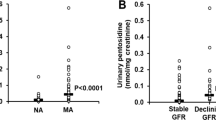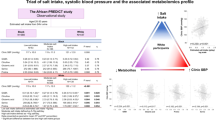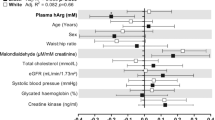Abstract
Background/Objectives:
Advanced glycation end products (AGEs) are implicated in the pathogenesis of atherosclerosis, diabetes and kidney disease. The objective was to describe dietary intake, the dominant source of exposure to AGEs, with carboxymethyl-lysine (CML), a major AGE, in serum and urine, respectively.
Subjects/Methods:
Serum and urinary CML were measured in 261 adults, aged 21–69 years, and compared with diet as assessed by six separate 24-h dietary recalls.
Results:
Median (25th, 75th percentile) serum and urinary CML concentrations were 686 (598, 803) μg/l and 1023 (812, 1238) μg/gm creatinine. There was no correlation between serum and urinary CML (r=−0.02, P=0.78). Serum CML was positively correlated with intake of soy, fruit juice, cold breakfast cereal, non-fat milk, whole grains, fruit, non-starchy vegetables and legumes, and negatively correlated with intake of red meat. Intake of fast food was not significantly correlated with serum CML. Urinary CML was positively correlated with intake of starchy vegetables, whole grains, sweets, nuts/seeds and chicken, and negatively correlated with intake of fast foods. Intake of AGE-rich foods such as fried chicken, French fries, bacon/sausage and crispy snacks were not significantly correlated with serum or urinary CML, except for a significant negative correlation between fried chicken and serum CML.
Conclusions:
These findings suggest that the high consumption of foods considered high in CML is not a major determinant of either serum or urinary CML. Further work is needed to understand the relationship of AGEs in blood and urine with the metabolism of dietary AGEs.
This is a preview of subscription content, access via your institution
Access options
Subscribe to this journal
Receive 12 print issues and online access
$259.00 per year
only $21.58 per issue
Buy this article
- Purchase on Springer Link
- Instant access to full article PDF
Prices may be subject to local taxes which are calculated during checkout
Similar content being viewed by others
References
Ahmed N, Mirshekar-Syahkal B, Kennish L, Karachalias N, Babaei-Jadidi R, Thornalley PJ (2005). Assay of advanced glycation endproducts in selected beverages and food by liquid chromatography with tandem mass spectrometric detection. Mol Nutr Food Res 49, 691–699.
Ames JM (2007). Evidence against dietary advanced glycation endproducts being a risk to human health. Mol Nutr Food Res 51, 1085–1090.
Ames JM (2008). Determination of Nɛ-(carboxymethyl)lysine in foods and related systems. Ann NY Acad Sci 1126, 20–24.
Arab L, Wesseling-Perry K, Jardack P, Henry J, Winter A (2010). Eight self-administered 24-h dietary recalls using the internet are feasible in African Americans and whites: the Energetics Study.J Am Diet Assoc 110, 857–864.
Assar SH, Moloney C, Lima M, Magee R, Ames JM (2009). Determination of Nɛ-(carboxymethyl)lysine in food systems by ultra performance liquid chromatography-mass spectrometry. Amino Acids 36, 317–326.
Basta G (2008). Receptor for advanced glycation endproducts and atherosclerosis: from basic mechanisms to clinical implications. Atherosclerosis 196, 9–21.
Bemelmans-Spork M, Sikkel D (1985). Data collection with handheld computers. Proceedings of the 45th session, Den Hague, The Netherlands: International Statistical Institute, Book III, topic 18(3).
Boehm BO, Schilling S, Rosinger S, Lang GE, Lang GK, Kientsch-Engel R et al. (2004). Elevated serum levels of Nɛ-carboxymethyl-lysine, an advanced glycation end product, are associated with proliferative diabetic retinopathy and macular oedema. Diabetologia 47, 1376–1379.
Conway JM, Ingwersen LA, Vinyard BT, Moshfegh AJ (2003). Effectiveness of the US Department of Agriculture 5-step multiple-pass method in assessing food intake in obese and non-obese women. Am J Clin Nutr 77, 1171–1178.
Food and Nutrition Board, Institute of Medicine (2000). Dietary Reference Intakes. Applications in Dietary Assessment: a Report of the Subcommittees on Interpretation and Uses of Dietary Reference Intakes and Upper Reference Levels of Nutrients, and the Standing Committee on the Scientific Evaluation of Dietary Reference Intakes, Food and Nutrition Board, Institute of Medicine. The National Academies Press: Washington, DC.
Förster A, Kühne Y, Henle T (2005). Studies on absorption and elimination of dietary Maillard reaction products. Ann NY Acad Sci 1043, 474–481.
Greenwald SE (2007). Ageing of the conduit arteries. J Pathol 211, 157–172.
Henle T (2003). AGEs in foods: do they play a role in uremia? Kidney Int 63 (Suppl 84), S145–S147.
Hervey GR (1953). Determination of creatinine by the Jaffe reaction. Nature 171, 1125.
International Physical Activity Questionnaire (2009): http://www.ipaq.ki.se/ipaq.htm (accessed 1 July 2009).
Kilhovd BK, Juutilainen A, Lehto S, Rönnemaa T, Toriesen PA, Hanssen KF et al. (2007). Increased serum levels of advanced glycation endproducts predict total, cardiovascular and coronary mortality in women with type 2 diabetes: a population-based 18 year follow-up study. Diabetologia 50, 1409–1417.
Monnier VM, Mustata GT, Biemel KL, Reihl O, Lederer MO, Zhenyu D et al. (2005). Cross-linking of the extracellular matrix by the Maillard reaction in aging and diabetes: an update on ‘a puzzle nearing resolution’. Ann NY Acad Sci 1043, 533–544.
Pischetsrieder M (2007). Special issue: Are dietary AGEs/ALEs a health risk? Mol Nutr Food Res 51, 1069–1119.
Šebeková K, Krajèovièová-Kudláèková M, Schinzel R, Faist V, Klvanová J, Heidland A (2001). Plasma levels of advanced glycation end products in healthy, long-term vegetarians and subjects on a western mixed diet. Eur J Nutr 40, 275–281.
Šebeková K, Somoza V (2007). Dietary advanced glycation endproducts (AGEs) and their health effects – PRO. Mol Nutr Food Res 51, 1079–1084.
Šebeková K, Somoza V, Jarcusková M, Heidland A, Podracká L (2009). Plasma advanced glycation end products are decreased in obese children compared with lean controls. Int J Pediatr Obes 4, 112–118.
Semba RD, Nicklett EJ, Ferrucci L (2010a). Does accumulation of advanced glycation end products contribute to the aging phenotype? J Gerontol A Biol Sci Med Sci 65, 963–975.
Semba RD, Bandinelli S, Sun K, Guralnik JM, Ferrucci L (2009a). Plasma carboxymethyl-lysine, and advanced glycation end product, and all-cause and cardiovascular disease mortality in older community-dwelling adults. J Am Geriatr Soc 57, 1874–1880.
Semba RD, Beck J, Sun K, Egan JM, Carlson OD, Varadhan R et al. (2010b). Relationship of a dominant advanced glycation end product, serum carboxymethyl-lysine, and abnormal glucose metabolism in adults: the Baltimore Longitudinal Study of Aging. J Nutr Health Aging 14, 507–513.
Semba RD, Ferrucci L, Sun K, Beck J, Dalal M, Varadhan R et al. (2009b). Advanced glycation end products and their circulating receptors predict cardiovascular disease mortality in older community-dwelling women. Aging Clin Exp Res 21, 182–190.
Semba RD, Najjar SS, Sun K, Lakatta EG, Ferrucci L (2009c). Serum carboxymethyl-lysine, an advanced glycation end product, is associated with increased aortic pulse wave velocity in adults. Am J Hypertens 22, 74–79.
Uribarri J, Cai W, Peppa M, Goodman S, Ferrucci L, Striker G et al. (2007). Circulating glycotoxins and dietary advanced glyation endproducts: two links to inflammatory response, oxidative stress, and aging. J Gerontol A Biol Sci Med Sci 72, 427–433.
Uribarri J, Peppa M, Cai W, Goldberg T, Lu M, Baliga S et al. (2003). Dietary glycotoxins correlate with circulating advanced glycation end product levels in renal failure patients. Am J Kidney Dis 42, 532–538.
Zhang X, Frischmann M, Kientsch-Engel R, Steinmann K, Stopper H, Niwa T et al. (2005). Two immunochemical assays to measure advanced glycation end-products in serum from dialysis patients. Clin Chem Lab Med 43, 503–511.
Acknowledgements
This study was supported by the National Institutes of Health Grants R01 CA105048, R01 AG027012, R01 AG029148, R01 HL094507 and R37 AG019905, and the Intramural Research Program, National Institute on Aging, NIH.
Author information
Authors and Affiliations
Corresponding author
Ethics declarations
Competing interests
The authors declare no conflict of interest.
Rights and permissions
About this article
Cite this article
Semba, R., Ang, A., Talegawkar, S. et al. Dietary intake associated with serum versus urinary carboxymethyl-lysine, a major advanced glycation end product, in adults: the Energetics Study. Eur J Clin Nutr 66, 3–9 (2012). https://doi.org/10.1038/ejcn.2011.139
Received:
Revised:
Accepted:
Published:
Issue Date:
DOI: https://doi.org/10.1038/ejcn.2011.139
Keywords
This article is cited by
-
Association of major dietary patterns with advanced glycation end products and high-sensitivity C-reactive protein in people with type 1 diabetes mellitus
Nutrition Journal (2023)
-
Glyoxal in hyperglycaemic ischemic stroke – a cohort study
Cardiovascular Diabetology (2023)
-
Metabolic transit of dietary advanced glycation end-products - the case of NƐ-carboxymethyllysine
Glycoconjugate Journal (2021)
-
Excess free fructose, apple juice, high fructose corn syrup and childhood asthma risk – the National Children’s Study
Nutrition Journal (2020)
-
Implication of advanced glycation end products (Ages) and their receptor (Rage) on myocardial contractile and mitochondrial functions
Glycoconjugate Journal (2016)



